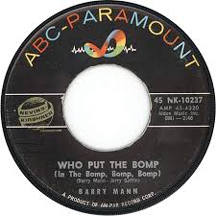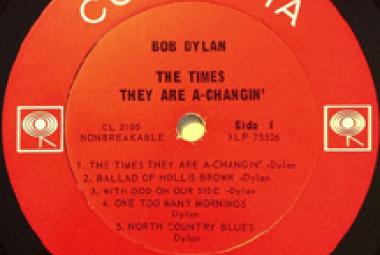Who Put The Bomp was a rock music fanzine edited and published by Greg Shaw from 1970 to 1979. Its name came from the hit 1961 doo-wop song by Barry Mann, "Who Put the Bomp". Later the name was shortened to "Bomp!". Shaw was one of the first and best known rock fanzine editors, having founded one of the earliest rock fanzines, the mimeographed "Mojo Navigator and Rock 'n Roll News" in 1966. "Bomp!" was an early publishing venue for many subsequently well-known writers, including Lester Bangs and Greil Marcus. "Bomp!" later morphed into an independent record label, Bomp! Records, headed by Shaw until his death in 2004. (More from Wikipedia)
After Greg Shaw and Suzy Shaw moved to Los Angeles, the first issue of a new magazine came out – at the very end of the 1960's (in January 1970) – under the title of Who Put the Bomp. A loose-knit organization called Rock Enthusiasts Amateur Press (R.E.A.P.) – which only had a membership of around 13 – was started by Louis Morra, and he invited Greg Shaw among others to rush a fanzine to press. Greg Shaw was an inveterate publisher in this period and was also publishing several other newsletters having various arcane purposes; these include Karnis Bottle's Metanoia, Liquid Love, Alligator Wine, and Rock You Sinners!.
The name of the magazine is taken from "Who Put the Bomp (in the Bomp, Bomp, Bomp)", a Top-40 hit by Barry Mann.
No known copies of this first issue of Who Put the Bomp are known to exist; it probably contained only 2 to 6 pages. Greg Shaw himself thought that another fanzine called Trash was the best among what he termed a "terrible" bunch. But from these quite humble beginnings grew a substantial rock and roll empire.
* * *
The idea for the Who Put the Bomp magazine originally was that the title of each issue would be taken from the name of a great rock song; thus, the second issue was to have been called Da Doo Ron Ron. Greg Shaw was persuaded that this was not a good idea for an ongoing publication, so the issue was named Who Put the Bomp #2, with Da Doo Ron Ron as the subtitle. This practice was dropped after the third issue, although the initials R.I.A.W.O.L. were frequently present on the front page, standing for "Rock Is a Way of Life".
"Da Doo Ron Ron" was a #3 hit in 1963 for the girl-group the Crystals; and it was written by another famous 1960's songwriter couple, Jeff Barry and Ellie Greenwich, together with Phil Spector (now infamous for his 2009 conviction for a murder in his home in 2003). This song is a classic example of Spector's legendary "wall of sound" production technique.
* * *
The third issue of Who Put the Bomp was subtitled Whenever a Teenager Cries; whereas I grew up with the other two songs and loved them both, I wasn't familiar with this song. Their 1964 song "Whenever a Teenager Cries" was by one of Greg Shaw's favorite girl groups, Reparata & the Delrons. (I did find the song on YouTube, and it is another great one without a doubt).
The songwriter is Ernie Maresca; while I didn't really know that name either, I certainly know his work: He wrote or co-wrote several of the biggest hits by Dion, including "Runaround Sue", "The Wanderer" and "Donna the Prima Donna". Maresca was also the songwriter behind one of my own favorite lesser known early 1960's songs, "Party Girl" by Bernadette Carroll. I stumbled upon the song again on a compilation album not that long ago.
* * *
Now, of all of the songs that Greg Shaw could have used to name and then subtitle his magazine Who Put the Bomp, two of them came out in 1963, and the other in 1964, though that one could just as easily have been made in 1963. Why 1963? Greg Shaw was 14 in 1963; and, according to neuroscientist and author Daniel Levitin in his book, This is Your Brain on Music, this is when the brain is most susceptible to the influence of music. As quoted in Bomp 2, Levitin writes: "Part of the reason we remember songs from our teenage years is because those years were times of self discovery, and as a consequence, they were emotionally charged."
Many years later, Greg Shaw wrote in 2001: "One of my favorite phases of 60's garage was 1963, when nobody had ever heard of England, and songs like 'Louie Louie' [by the Kingsmen] and 'Surfin' Bird' [by the Trashmen] were drawing on 50's R&B to create something new."
* * *
Greg Shaw continued publishing Who Put the Bomp with ideas both modest and grandiose; in the sixth issue for instance, he introduced a bold mission statement: "Prelude to the Morning of an Inventory of the 60's". The name of the magazine would eventually be shortened to just Bomp!, and the 22nd issue that was due to come out in 1981 was never published.
* * *
Two years after the publication of Bomp!: Saving the World One Record at a Time, Suzy Shaw and the editor of Ugly Things magazine, Mike Stax edited another book, Bomp 2 – subtitled Born in the Garage and sub-subtitled Greg Shaw and the Roots of Rock Fandom 1970-1981!. This book looks a lot like a big issue of Ugly Things and consists of a detailed catalogue of Greg Shaw's publications over that period, and numerous excerpts from Who Put the Bomp and the other fanzines that were published over this period that were not included in the first book. These books are among my most treasured publications, and they are both autographed by Suzy Shaw.
(May 2013)
* * *
As mentioned, Kim Fowley is best known as the man who brought together the early all-female rock band the Runaways. In 1974 or 1975, he placed an ad in the fanzine Who Put the Bomp looking for women who wanted to start an all-female rock band. He got zero responses; but eventually, drummer Sandy West and rhythm guitarist Joan Jett introduced themselves to Fowley, and the band was in place by late 1975. As Fowley recalls (from Wikipedia): "I didn't put the Runaways together; I had an idea, they had ideas, we all met, there was combustion; and out of five different versions of that group came the five girls who were the ones that people liked."
(January 2015/1)















